On October 8th 2016, I gave a lecture together with Chiara Birattari as representatives of Serpica Naro collective during A symposium on architecture, territory and production organized in Prato by Behemoth Press as parallel project of the Oslo Architecture Triennale 2016 – After Belonging.

Here’s the introduction to the event:
The Life of a District On the 1st December 2013, precisely two years ago, the sweatshop “Ye Life Pronto Moda” in the Chinese textile district of Prato went on fire. Seven workers lost their lives in the accident and five of them without regular work permit. Among the ruins of the collapsed workshop there were not only sewing machines, fabrics and offcuts but also dozens of beds, clothes, personal belongings and cooking equipment all packed in the mezzanine.
Yet, the domestic conditions of production of the Chinese “Macrolotto” were not new in Prato. At least since the XIX century, the city always constituted an exception to the market rules, avoiding large industrial conglomerations or a rigid compartmentalisation of the productive sectors, integrating housing and factories within a unique continuous infrastructure. Especially after WWII, in order to reduce costs and have a rapid reconstruction, textile factories sold their looms to the workers, decentralising their integrated mills to family houses and storage places, transforming the city itself into a horizontal manufacture: a territorial assembly line made of a network of domestic companies.
During the 80’s, in order to tackle the deep crisis of wool market and to adapt to new fashion tendencies, textile industry had to further accelerate its delocalisation and mechanisation, implementing production with highest rhythms and more flexible workforce to ensure a prompt fulfilment of the mass consumption’s demands. At that time Chinese immigration began, transforming the rising sub-contracting garment industry into a true business model: the “pronto moda.” Setting a series of ten-people companies, importing low quality fabric from China, processing it and labelling it as “Made in Italy”, hiring workers without regular labor contracts and forcing them to insane working rhythms, the textile city-factory boosted during the 90s, with more than 200 Chinese-owned business firms in operation and a basin of more than 50.000 inhabitants: the second biggest Chinese community in Italy.
Drawing from Prato as exemplary study-case, and through a comparison with other Italian and European examples, Behemoth Press aims at an architectural investigation of the notion of Industrial District, namely that socio-territorial entity characterised by the presence of an active community of people and business companies intimately connected within a logistic network of cooperating suppliers and producers.
Industrial districts are weird animals. Whereas globalisation and neoliberal production seem to homogenise territories and destroy local realities, within the protected compound of the industrial district companies are able to produce difference, innovative approaches and specialisation, creative experimentation and mutual support.
Firmly rooted in their territories, districts propose a very particular relation between living and working, cooperation and competition, transforming their localised concentration into a competitive asset, attracting international fundings and the support of research institutes and universities. In this sense, the industrial district might be considered not only as a investment opportunities for advanced technologies of production and automation but also as laboratories to explore new forms of employment and income for their inhabitants.
Contributors:
- Massimo Bressan [Professor, Faculty of Political Science, University of Florence]
- Marco Brizzi [Professor, School of Architecture of California State University and Kent State University Florence]
- Matilde Cassani [Architect, Photographer, Politecnico di Milano]
- Filip Geerts [Assistant Professor, School of Architecture, TU Delft]
- Claudio Greppi [Professor, History Department, University of Siena]
- Christina Moon [Assistant Professor, Fashion Studies, Parsons School of Design New York]
- Serpica Naro [Design Collective, Milan]
- Giorgio Piccinato [Professor Emeritus, School of Architecture, University of RomaTre]
- Silvia Pieraccini [Journalist, IlSole24Ore]
- Paola Viganò [Professor, School of Architecture, IUAV Venice, EPFL Lausanne]
- Marina Otero-Verzier [Oslo Architecture Triennale – Head of Research, Het Nieuwe Instituut]

